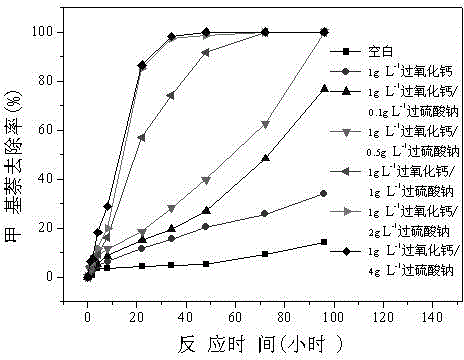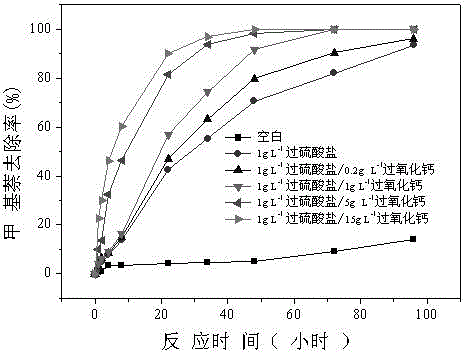Method for removing polycyclic aromatic hydrocarbon methylnaphthalene substance by adopting double oxidants including persulfate and calcium peroxide
A double oxidant and persulfate technology, applied in chemical instruments and methods, water treatment of special compounds, oxidized water/sewage treatment, etc., can solve the problems of large influence of microorganisms, short effective time of in-situ chemical oxidants, instability, etc. , to achieve the effect of expanding the degradation range, improving the efficiency of bioremediation, and facilitating transportation
- Summary
- Abstract
- Description
- Claims
- Application Information
AI Technical Summary
Problems solved by technology
Method used
Image
Examples
Embodiment 1
[0028] Dissolve 0.1g of calcium peroxide in a certain amount of ultrapure water, place it on a stirrer and stir evenly, add dilute nitric acid solution to adjust the pH of the system to 7, add methylnaphthalene, and add ultrapure water until the final volume of the system is 100mL. The reaction was uniformly stirred at room temperature for 96 hours, and the removal of methylnaphthalene, a polycyclic aromatic hydrocarbon, was completed by using calcium peroxide alone. The removal rate of methylnaphthalene 96h reaches 34% in the present embodiment.
Embodiment 2
[0030] Dissolve 0.1g of calcium peroxide and 0.01g, 0.05g, 0.1g, 0.2g and 0.4g of sodium persulfate in a certain amount of ultrapure water respectively, place them on a stirrer and stir evenly, add dilute nitric acid solution to adjust the system respectively When the pH reached 7, methylnaphthalene was added, and ultrapure water was added until the final volume of the system was 100 mL. The reaction was uniformly stirred at room temperature for 96 hours, and the method for removing polycyclic aromatic hydrocarbons methylnaphthalene by using persulfate-calcium peroxide double oxidant was completed. The removal rates of methylnaphthalene in this example were 77% (96h), 100% (96h), 100% (72h), 100% (72h) and 100% (48h).
Embodiment 3
[0032] Dissolve 0.1g of sodium persulfate in a certain amount of ultrapure water, place it on a stirrer and stir evenly, add dilute NaOH solution to adjust the pH of the system to 7, add methylnaphthalene, and add ultrapure water until the final volume of the system is 100mL. The reaction was uniformly stirred at room temperature for 96 hours, and the removal of methylnaphthalene, a polycyclic aromatic hydrocarbon, was completed by using persulfate alone. The removal rate of methylnaphthalene 96h reaches 95% in the present embodiment.
PUM
 Login to View More
Login to View More Abstract
Description
Claims
Application Information
 Login to View More
Login to View More - R&D
- Intellectual Property
- Life Sciences
- Materials
- Tech Scout
- Unparalleled Data Quality
- Higher Quality Content
- 60% Fewer Hallucinations
Browse by: Latest US Patents, China's latest patents, Technical Efficacy Thesaurus, Application Domain, Technology Topic, Popular Technical Reports.
© 2025 PatSnap. All rights reserved.Legal|Privacy policy|Modern Slavery Act Transparency Statement|Sitemap|About US| Contact US: help@patsnap.com



